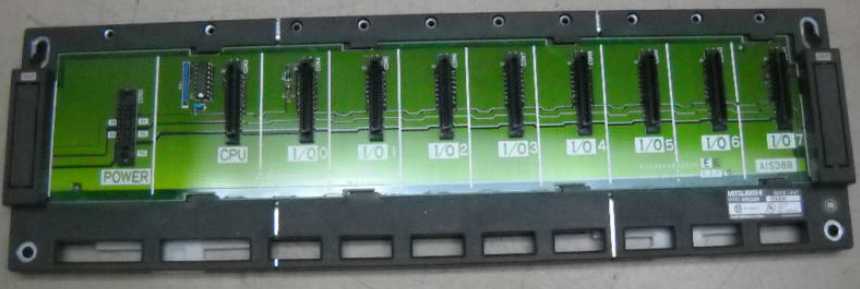Home
>> Products
>> MITSUBISHI
>> Ans/QnAs series PLC
>> Bottom plate / expansion floor / extension cable
>> A1S38B CPU substrate
A1S38B CPU substrate
MITSUBISHI A1S38B Manual And Instructions
A1S38B datasheetPDF datasheet
MITSUBISHI A1S38B Product information and technical parameters:
Brand: MITSUBISHI
Name: CPU substrate
Model: A1S38B
I/O slots: 8 slots.
Outline dimension: 430*130.
CPU basic board can be plugged into 1 power modules,
1 CPU components and a maximum of 2, 3, 5, or 8 single slot size special function components and I/O components are respectively inserted and arranged.
Expansion ports are arranged on both sides of the base plate,
For connecting the expansion board for.
Up to 3 extension substrates.
...More relevant models >>>>
A1S38B datasheetPDF datasheet
MITSUBISHI A1S38B Product information and technical parameters:
Brand: MITSUBISHI
Name: CPU substrate
Model: A1S38B
I/O slots: 8 slots.
Outline dimension: 430*130.
CPU basic board can be plugged into 1 power modules,
1 CPU components and a maximum of 2, 3, 5, or 8 single slot size special function components and I/O components are respectively inserted and arranged.
Expansion ports are arranged on both sides of the base plate,
For connecting the expansion board for.
Up to 3 extension substrates.
Input and output points: 1024 points.
Input / output data points: 8192 points.
Program capacity: 60k.
Basic command processing speed (LD command) S:0.075.
PLC in the program execution stage: according to the order of the user program order to store the order of each instruction,
After the corresponding operation and processing, the result is written to the output status register,
The contents of the output status register are changed with the execution of the program A1S38B A1S38B
Output refresh phase: when all instructions are executed,
The output status register is sent to the output latch in the output refresh stage,
And through a certain way (relay, transistor or transistor) output, drive the corresponding output equipment A1S38B. SI/QSI/H-PCF/ wide H-PCF optical cable double loop PC (control station / common station) / remote I/O network (remote master station).
Switch volume control is designed to,
According to the current input combination of the switch quantity and the history of the input sequence,
So that PLC generates the corresponding switching output,
In order to make the system work in a certain order A1S38B.
So, sometimes also known as the order control.
And sequential control is divided into manual, semi-automatic or automatic.
And the control principle is decentralized, centralized and hybrid control three.
The length of time required to execute the instruction, the length of the user''s program, the type of instruction, and the speed of the CPU execution are very significant,
Generally, a scanning process, the fault diagnosis time,
Communication time, input sampling and output refresh time is less,
The execution time is accounted for the vast majority of.
The response time of PLC is the interval between the time of the change of the external output signal oof the PLC and the time of the change of the external output signal which is controlled by it,
Lag time, this is the time constant of the input circuit,
The time constant of the output circuit, the arrangement of the user statement and the usse of the instruction,
The cycle scan mode of PLC and the way of PLC to refresh the I/O and so on A1S38B A1S38B.
This phenomenon is called the I/O delay time effect.
Input / output data points: 8192 points.
Program capacity: 60k.
Basic command processing speed (LD command) S:0.075.
PLC in the program execution stage: according to the order of the user program order to store the order of each instruction,
After the corresponding operation and processing, the result is written to the output status register,
The contents of the output status register are changed with the execution of the program A1S38B A1S38B
Output refresh phase: when all instructions are executed,
The output status register is sent to the output latch in the output refresh stage,
And through a certain way (relay, transistor or transistor) output, drive the corresponding output equipment A1S38B. SI/QSI/H-PCF/ wide H-PCF optical cable double loop PC (control station / common station) / remote I/O network (remote master station).
Switch volume control is designed to,
According to the current input combination of the switch quantity and the history of the input sequence,
So that PLC generates the corresponding switching output,
In order to make the system work in a certain order A1S38B.
So, sometimes also known as the order control.
And sequential control is divided into manual, semi-automatic or automatic.
And the control principle is decentralized, centralized and hybrid control three.
The length of time required to execute the instruction, the length of the user''s program, the type of instruction, and the speed of the CPU execution are very significant,
Generally, a scanning process, the fault diagnosis time,
Communication time, input sampling and output refresh time is less,
The execution time is accounted for the vast majority of.
The response time of PLC is the interval between the time of the change of the external output signal oof the PLC and the time of the change of the external output signal which is controlled by it,
Lag time, this is the time constant of the input circuit,
The time constant of the output circuit, the arrangement of the user statement and the usse of the instruction,
The cycle scan mode of PLC and the way of PLC to refresh the I/O and so on A1S38B A1S38B.
This phenomenon is called the I/O delay time effect.
...More relevant models >>>>
Related download


 Last one:
Last one:  next one:
next one: